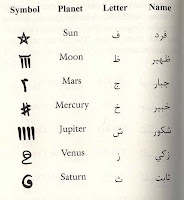The highest name of Allah or "ismillahi l-asma"
Because of the lack of translations of the Arabic occult literature, the western culture knows very little about the facts and origin of many magical symbols which can be found in most of the rituals that are performed today. Most of the symbols that we come across in rituals of various magical schools are of an Egyptian origin and no one should wonder that Egypt has been the cradle of magic and the occult from its early days.
The hexagram or the six-pointed star is an Arabic symbol which was used in the 18th century by the Jewish family Rothschild with the intent of making it a symbol of Judaism calling it the "Star of David". But the origin of the hexagram needs to be found in the ancient Egypt cult of magic and wizardry. That is the reason why we see this symbol in a lot of the Arabic talismans and amulets.
Similar mistakes are found in the name "Seven Signs of Solomon" which have nothing to do with this magician king. The origin of these signs was best described by the grand Arabic occultist, Ahmad ibn Ali al-Buni:
The first of the five signs is the five-pointed star, the old Arabic symbol of protection, one of the favorite and most widespread which is seen in the fact that Islam still holds on to it, whose symbol is crescent moon and a star.
The second sign contains three vertical lines and one wavy line. Its meaning is not completely known.
The third sign is actually the letter Mim, the first letter of the name Muhammad.
The fourth sign represents the ladder, which according to al-Buni represent closeness to God.
The sixth and the seventh sign are the letters Ha and Waw which, when combined form the word Huwa or He, one of the symbols of God in the Qur'an.
Al-Buni believes that these seven signs represent the supreme name of Allah and according to that each talisman and amulet that are written or etched with these symbols ensure God's protection and power.
Vedrana Rudan: I Feel Sorry for the Jews
Some facts have been crystal clear, not just since yesterday. Israel is a fascist state. Gaza is a huge concentration camp where Palestinian...

-
For a man's penis to be strong and hard, the following signs should be written on a white porcelain plate. After writing the magic sign...
-
There is probably no person who does not know what a talisman or amulet (zapis or hamajlija on Bosnian language), is. It is a short or long...


